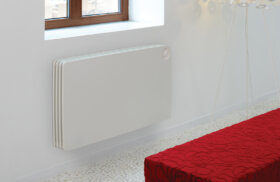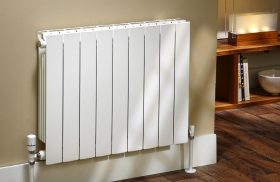Thankfully, radiators aren’t just for providing heat these days! As homeowners try to create a particular look, the style of the radiator is just as important as how well it performs. Vintage-style period cast iron radiators are having a resurgence, but practical radiators that fit into specific spaces are equally popular.
Early days in Ancient Rome
The history of the radiator, as it turns out, is quite an old one. They were providing central heat in a home dates back to Ancient Rome when the hypocaust was invented. This type of heat involved using a furnace to add heat to the air and then sending that heat to open spaces beneath floors where it warmed the rooms above – the earliest form of underfloor heating. Hypocausts were used to heat the famous baths and in private homes in the northern territories of the Roman Empire.
A similar heating system was developed in ancient Korea – the ondol is thought to go back thousands of years. The Chinese also have a similar system, the king, that is still in use today.
In the Middle Ages, the use of hypocausts pretty much died out in Europe. However, the technology continued to be used in Byzantine and Arab countries, and it was reintroduced in the 13th century in the Alhambra Palace in Spain. As it spread to the northern countries in the 14th century, hypocaust technology was improved by the addition of granite stones that were piled on top of the furnace to accumulate and store heat. This new kind of low-tech heating system was the first to use convection heating, where a series of vents allowed the hot air to heat a room.
However, it wasn’t until the 19th century that technology enabled Western engineers to devise what developed into the central heating systems we know and love today.
To visit one of our radiator showrooms
St Albans | Brighton | Islington | Clapham | Leamington Spa | Bristol
The modern radiator
Maybe it’s because radiators have such ancient origins that it’s difficult to pin down just one inventor of the modern radiator – several people have claimed to have been the first to make one. Franz San Galli, a Russian businessman, developed an early radiator in 1857. Robert Briggs and Joseph Nason pioneered the art of heating buildings by steam and came up with a radiator system using vertical iron tubes in 1863. The year 1872 saw the invention of the ‘Bundy Loop’, a popular design that created the kind of early radiators that form the basis of many modern heating products.
In the second half of the 19th century, cast iron radiator systems became hugely popular in America. Three manufacturers of those radiators merged to become the American Radiator Company, which then crossed the Atlantic and began manufacturing radiators in Hull at the turn of the 20th century.
The new, highly decorative radiators gained popularity, but it wasn’t until the 1950s, when steel radiators took over in popularity, that central heating systems became the norm in UK homes. By the end of the 20th century, cast iron radiators were seen as too old-fashioned and bulky for modern living. But with the advent of designer radiators and the realisation that radiators can be as ‘cool’ as they are warm, there has been a resurgence in interest in the old-style cast iron radiator, alongside modern and funky models. A radiator is no longer an ugly strip of steel that you’d rather not have to look at, it’s now an interior design statement.





